
I've been using Windows 7 for about a week now. I plunked down some green for the upgrade from Vista. Overall, I'm happy with the upgrade. 7 does some cool things that make me happier to use my computer. There are a few bugs and quirks that I am figuring out (like hibernation killing my fingerprint reader), but general operation is just as smooth as before, if not more so.
Some people have claimed performance increases over Vista. I haven't seen anything overtly noticeable on my machine in just normal use. I did do an in-place upgrade so I wouldn't have to reinstall all my software. Any OS will be faster after a clean install, so take that with the requisite portion of NaCl.
As for presentation stuff, I think Win7 might just have a few killer apps that will make you happy to get a new laptop with it installed. Pressing the Windows Key and 'P' will trigger an easy to understand selection of the display options (computer only, duplicate the display, extend the display, projector only). No more hunting and dinking and pressing Fn+f8 repeatedly while the audience is waiting for you to get started.
I also love, LOVE, the new taskbar. If the Mac and PC characters from the commercials had a baby. The cute kid would be the Win7 taskbar. It does the dock stuff that has been so cool on OSX, but it adds a Windows productivity twist. Jump-lists. If you right click on a program on the taskbar you will see a list of files recently opened by that program (just PowerPoint or Word, not all your recent documents). And you can pin certain files to the list, so say you are working on a PowerPoint presentation and you get to where you are going to present - just access the jumplist and find your file (or pin it there the night before the presentation to make it even easier). One step gets your presentation open and ready! So cool.
Am I gushing? I might be. I'll have more thoughts as I play with things, but my first impressions are favorable. I would say that if you bought your computer in the last year or so and don't plan to upgrade for a while, the Win7 upgrade might be a good move. If you are looking at getting a new machine in the next year or so, just wait and get Win7 preinstalled.

